The Prince Of A Professor & The Man In Birkenstocks
Wednesday, December 24, 2008
My friend Graham Walker and I listened to Johann Sebastian Bach's Cantata BWV 36 at the Chan last night. The first line sung jointly by soprano Suzie LeBlanc, alto Laura Pudwell, tenor Colin Balzer and baritone Sumner Thompson:
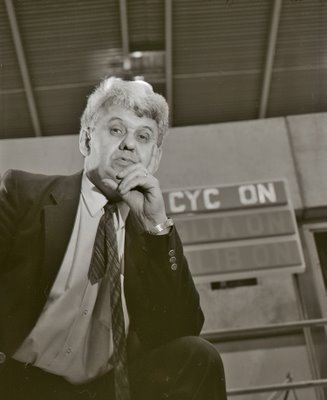 Schwingt freudig euch empor zu den erhabnen Sternen (soar joyfully aloft amidst the starry grandeur)
Schwingt freudig euch empor zu den erhabnen Sternen (soar joyfully aloft amidst the starry grandeur) made me think of a possibly unlikely meeting between two men who were present. One of them was wearing extremely casual clothing and his trademark socked Birkenstocks, the other, a Kodiak bear of a man with white hair, was sitting two persons away from us. I found this extreme urge to loudly greet him in the following manner (and I did), "Dr Vogt how is your cyclotron?" He looked at me with a smile and said, "It's doing just fine."
The two students sitting between us and Dr Erich Vogt asked me, "What's a cyclotron?" Luckily I was able to answer a vague, "It's a particle accelerator and this man headed UBC's TRIUMF for years." I really wanted to answer stuff like, "He deals with particles called charmed quarks. A cyclotron is a donut-shaped chamber that accelerates electrons, protons and other particles at extremely high speeds. When these speeds reach relativistic speeds (nearing the speed of light) then you have an out-of-phase problem and that is why particle accelerators are now not circular but miles long." For more on the extraordinary Dr. Vogt read below:
Erich and the KAON Factory
Erich Vogt and Kaons: The very political particles that weren't to be Canadian
By Eve Savory CBC News
Last Updated: Monday, May 5, 2008 | 2:27 PM ET
This weekend, three Nobel Prize winners and dozens of other scientists of the first order blew into Vancouver for a physics symposium — and a party.
Forty years ago, TRIUMF, Canada's national laboratory for particle and nuclear physics, was established and that alone is reason for a physicist to celebrate
But that's not what drew Carlo Rubbia, Dick Taylor and Walter Kohn to the gathering at the University of British Columbia (UBC). It was friendship for the man who co-founded TRIUMF — a man who never won a Nobel Prize but who has worked with some 30 winners, and a man celebrated for his commitment both to science and teaching.
Professor Emeritus Erich Vogt has taught 5,000 first-year physics students over the last 43 years.
Vogt is 78, and according to his students, a prince of a professor. Writes one at Ratemyprofessor.com: "This man is AMAZING. He got his PhD in Princeton in the 50s and had lectures of ALBERT EINSTEIN — !! not mentioning his OTHER Nobel Laureate friends!!"
"Incredible prof. about 200 years old and he's been teaching for free since he was 65," enthuses another.
"All other lecturers should sit in on some of his classes to learn how to teach," scolds a third.
For more on this man read the rest of this delightful CBC interview by Eve Savory here
I thought of Dr Vogt and José Verstappen the man in the Birckenstocks. Verstappen has headed Early Music Vancouver for at least 28 years. Such is his perseverance, intelligence and his knowledge not only of what people will like but what people should like that he was able to fill the Chan on the evening of a snow storm. His followers (I am, unabashedly, one of them) trust his taste for music and we attend his concerts(his society hires local musicians and mixes them in groups with musicians from abroad) all beautifully announced by the Early Music Vancouver Calendar that is mailed once a year and that my Rosemary magnets to the fridge. Verstappen could have lost his shirt last night considering that musical director and violinist Marc Destrubé hired the three best natural trumpet playes in North American to contribute for two of the Cantatatas (BMV 171 and BMV 248/6 Part VI). And there was the participation of those baroque oboists Washington McLain and Sand Dalton (not cheap, I am sure!). The band included many of the members of the Pacific Baroque Orchestra including the three-week mother Glenys Webster playing the viola while a violinist friend kept her thirsty Oscar Robin at bay backstage.
Verstappen did not lose his shirt and we all went home satiated with extremely good Bach. Driving home I thought of the musicians hugging each other and congratulating each other after the concert. I felt frustrated. I am not a musician. I can never be part of that club of people who can do that remarkable task of reading music and transfering that knowledge to an innanimate object made of old wood. The handshakes of the musicians are to me like the secret handshakes of a Masonic order. I can never share and can only watch from the outside. I looked at Dr. Vogt during those cantatas and I am sure that the elementary particle man can see into Bach and read into the meaning of the notes. It was plainly evident on his face. Perhaps there is a relationship between music protons and neutrons that Dr. Vogt is able to understand.
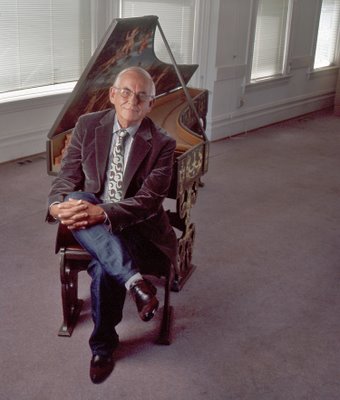
From my vantage point as an outsider I can only assert on this Christmas Eve that I am lucky, and that indeed we in Vancouver are lucky to have these two men in our midst.
Even with all the snow and the cloudy skies I don't have to be a musician or a particle physicist to soar joyfully aloft amidst the starry grandeur.
Lauren’s Sundae Hat, Therese’s Sturdy Legs, & A Coat Hanger Angel
Tuesday, December 23, 2008
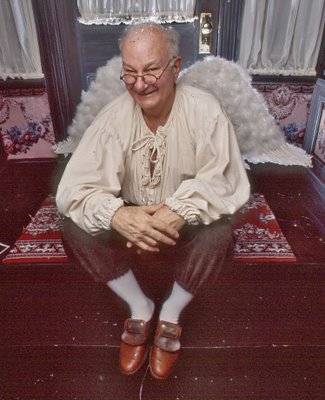 Guest Christmas Blog by John LekichThere is a thick blanket of snow on the ground the day Alex and I are set to meet Bernard Cuffling – the veteran Vancouver-based actor who plays Clarence the angel in the Arts Club production of It’s a Wonderful Life. Since I walk with a cane, snow has a tendency to make me a little grumpy. In my boyhood, seasoned gentleman used to tackle their sidewalks with homemade wooden shovels inspired by the business end of a snowplow. But old-school shoveling etiquette has fallen on hard times. Some people shovel and some people don’t - which makes for very uneven progress when you’re working with a personal ambulatory system that mimics one of Alex’s vintage tripods. My eyes are constantly fixed on the ground, watching for sudden changes in terrain. My legs stiffen up in anticipation of a sneaky patch of ice. It has a way of taking all the wonder out of gently falling snow. Still, the afternoon proves to have a few unexpected compensations. On the way to our interview, Alex makes a side trip to pick up his two granddaughters from school. While we wait for Rebecca’s class to return from an ice-skating expedition, Lauren chats away in the back seat. She is wearing a wool hat with a pom-pom that makes her head look like the top of a strawberry sundae. The pom-pom moves from side to side as she tries to remember the French word for chicken. She moves on to politely explain why she likes grape Jello better than lime. I ask her – rather non-committally – if she has played in the snow. “Yes!” she says, drawing out the word so that it ends with a sizzle of excitement. 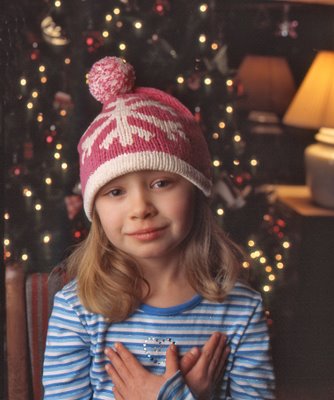 When we arrive backstage at the Arts Club on Granville Island, we get a nice surprise. “Look who I found!” says Alex. It’s Therese – a former Railway Club bartender whose easygoing charm never failed to delight us over many a long-lost Thursday lunch. Every once in a while, she would wear a tastefully abbreviated kilt over dancer’s leotards. Instantly melting the heart of the most callous barfly every time she ventured from behind the beer taps. In the middle of an icy winter, I would often envy the artful sturdiness of her legs. Alas, Therese Hartwig has long since abandoned mixology to wholeheartedly immerse herself in the more pragmatic aspects of theatrical life. When she throws her arms around my down-filled parka in greeting, she is wearing the kind of efficiently drab jumpsuit favoured by garage mechanics. Nevertheless, I find myself wishing that I was wearing a much thinner coat. My joy at seeing Therese again is matched only by meeting the gentlemanly Bernard Cuffling for the first time. I have been watching him in a long string of plays – starting with his 1975 debut in the Arts Club production of My Fat Friend. Originally from England, Cuffling has the kind of face that would look perfectly at home merrily toasting a reformed Ebenezer Scrooge in the Alastair Sim version of A Christmas Carol. As Alex takes Cuffling’s portrait, the actor is still wearing Clarence’s downy pair of angel wings. He will keep wearing then until the end of the play’s unreservedly successful run on January 3rd. I ask how it feels to wear the wings and he explains that they are held to his shoulders by a simple arrangement of coat hangers. “Do they stay on?” I ask. “Oh, yes,” he assures me. “We tried a lot of experiments. But it’s the only thing that really works.” For some reason, I find this coat hanger idea both comforting and inspiring. If something you find in an ordinary closet can successfully support such a wholly celestial concept as angel wings, any number of small miracles are possible. It’s a thought I cling to as I make my way to Alex’s car without incident. On the way home, the snow is lit by streetlamp. It streaks by in an endless ribbon - the dazzling white of an angel’s wing.
Food For Thought
Monday, December 22, 2008
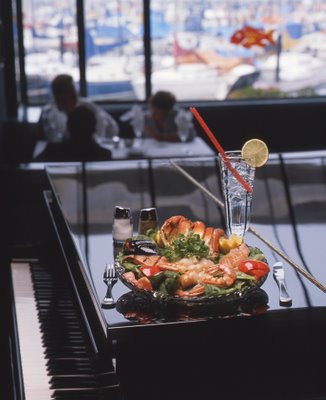 A cartoon in the Vancouver Sun this week had a sentence that began with, "I should have went..." Rosemary told me that since it is in the vernacular it will soon be correct. I am not sure it is correct now and I wonder if the artist of the cartoon knew better or just didn't. I suspect he didn't and that the cartoon was not vetted by the folks at the paper. In my photography classes at Focal Point and at Van Arts I have students who tell me they want to be fashion photographers or photo-journalists. Others tell me they want to shoot architecture or food. Some say they want to shoot for magazines. Whichever way you look at it, as things stand these days, I would say there is no immediate future in any of these specialized fields of photography. This is not because my students are not good enough to compete. They are competent and some are very good. The problem lies in the visual standards of web magazines and the fact that hard copy magazines are paying less and less. In my career in Vancouver I have avoided fashion because fashion in a city with little catalogue work (when I came Eaton's and the Bay did local catalogue work) means that after a couple of months of fashion fame, like a comet you will be over the horizon and replaced by the next one. Fashion is the kiss of death in Vancouver. For many years the tabletop food and beverage photographers did extremely well. The work of Deryk Murray comes to mind. He became prosperous enough to buy a bank on West Hastings by the Cenotaph and converted it into the best photo studio in town. Then the bottom fell out in the industry and Murray left town, (for a while). Shooting food and whiskey bottles with expertise is not easy. One needs all sorts of lighting resources. The investment in this kind of photography is expensive. It is as expensive as the photographers who shoot architectural interiors and are faced with the problem of not only making vertical columns in walls seem parallel but they must also balance interior lighting with the exterior. The photographer will need many powerful and expensive lights. The advent of digital means that a photographer can now shoot the exterior and the interior in separate exposures and then seamlessly meld them together. You would never know. But in order to make those parallel columns look parallel the photographer has to use an expensive 4x5 view camera and equip it with an even more expensive digital back if he or she hopes to compete in the diminishing market. My blog is a photo blog that specializes in portraits. I will bang on my own drum and point out that I am very good at it. I try to post photographs that are well taken and well lit. I will sometimes show garden shots but I have to admit I am an amateur. I would really never show you classical architecture shots because I have never been an architectural photographer. I am not Roger Brooks, one of the best of Vancouver's architectural photographers. The food shot here has a purpose. Let me explain. I will be the first person to state that I believe in good journalism. I believe in journalism written by journalists who studied their craft in school. I abhor citizen journalism. I believe that just because anybody can "publish" their opinion on line; it does not necessarily mean that it will be good. It generally isn't. Citizen journalists have ruined many a web-based magazine with their caustic rants. For a taste of that just look at the comments section in the on-line Globe & Mail. Where this citizen journalism really shows its amateur origins is in the realm of local Vancouver food blogs. If you look at any of the pictures you will be hard-pressed to find one that shows food in an appetizing manner. More often than not the food looks like stuff that is extruded from animals after their digestion. Shooting food is not easy. Shooting food to make it appetizing is not easy. Shooting food with a little or expensive digital camera that is unassisted by intelligent lighting will simply not work. I had to shoot the food picture you see here for a magazine that insisted that I do it. I took the picture at Monk McQueens in False Creek. For the picture I used a portable boom light stand so that I could suspend a largish soft box over the piano. Had I used an in-camera flash or available light the food would not have looked good. I think that I can give my opinion on the photographic side. On the writing side I can only assert that most of the food writing in food blogs does nothing for my appetite. Vancouver used to have James Barber but we still have Christina Burridge, Jurgen Gothe, Jamie Maw, Angela Murrils and a few others. Writing about food to make one want to go immediately to partake of it is not easy. A. J. Liebling, between meals, would have plenty to say about that. It has never been so evident how difficult that is. Just look at the food blogs. I may not be a good judge of the writing side of it but the photographs suck.
Una Navidad Colorada
Sunday, December 21, 2008
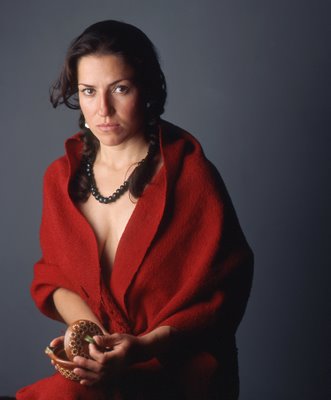 rojo, ja.(Del lat. russus). rojo, ja.(Del lat. russus).
1. adj. De color encarnado muy vivo, que corresponde a la sensación producida por el estímulo de longitudes de onda de alrededor de 640 nm o mayores. U. t. c. s. m. Es el primer color del espectro solar.
colorado, da.(Del lat. colorātus, de colorāre, colorar).
1. adj. Que tiene color.
2. adj. Que por naturaleza o arte tiene color más o menos rojo.
Real Academia Española © Todos los derechos reservadosRed and green are the colours of Christmas. Those who are religious say that red represents the blood shed by Christ to save mankind. Snobs might say that the month-long Roman Saturnalia decreed for December 25, AD 274 by Emperor Aurelian as natalis solis invicti ("birth of the invincible sun"), a festival honoring the sun god Mithras is the real origin of red. The reason is that at about the same time, the Church Fathers likewise set the official date for celebrating the birth of Jesus as being December the 25th. And since Christmas was appropriated from the Saturnalia by early Christians, when Italians celebrated Christmas in the 19th century the world copied the colours of the Italian flag. I think this reason is far-fetched and the most likely one is that the fat man wears a red suit. 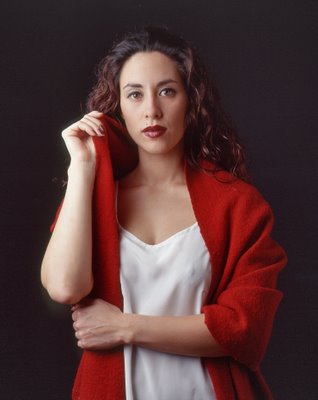 In Spanish we have two words for red, colorado and rojo. Both words come from the Latin. In Mexico rojo is used more than colorado. In my native Argentina the higher classes look down on the lower classes who use the crass sounding rojo while they the patricians opt for the more melodic colorado. Off colour jokes in Spanish are chistes colorados and dirty old men who are more likely to tell them are called viejos verdes or green old men. The most brilliant red I know is the vegetable dye red coloured Mexican rebozo my mother was given by her sister Dolly in Mexico City in 1952. It is made of a very rough cotton (Rebecca refuses to wear it saying it makes her itch). Mexico City at Christmas is not a white Christmas but it is a cold one. It was particularly cold in the 50s and 60s when I lived there as few houses or apartments had interior heating. I remember my mother wearing the red rebozo when she went to the Mexican Christmas posadas which are parties that mimic the act of the Virgin Mary and Joseph looking for a place to spend the night when Jesus was about to be born. The party goers sing outside of the party house for entrance and are denied several times until they are finally let in and the festivities begin. That red of my mother's rebozo screams Navidad to me. 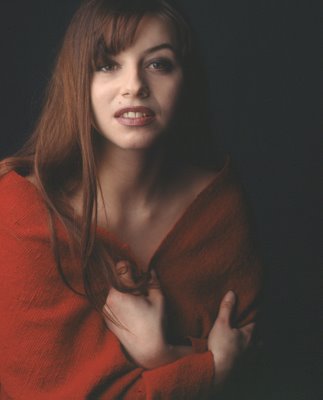 But I have used it to dress up and undress models since I first came to Vancouver 35 years ago. For the last four years I have taken it as a prop for my nude class at Focal Point. My students are dazzled by the colour and the fragrant scent of olinalá. Olinalá is a tropical tree that grows in Olinalá in the state of Guerrero. I have a chest made of the sweet smelling wood and I store my mother's collection of Mexican rebozos in it. Here are but a few of the women who have worn that red rebozo. In order of appearance it's Ivette Hernandez, Linda Lorenzo, Jennifer Froese and the last one I have long forgotten her name. The colour negative has deteriorated and she moved when I took this exposure. 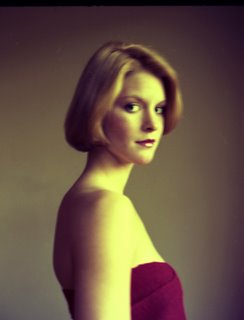 Even though I am unable to clear out the yellow I like it. Perhaps because it was the first time I took out my mother's rebozo from the olinalá chest for a photo. Every year I wrap the bottom of our Christmas tree with the red rebozo. In our home it is the real colour of Christmas.
shack-es-pear-eh
Saturday, December 20, 2008
"At Christmas I no more desire a rose
Than wish a snow in May's new-fangled shows;
But like of each thing that in season grows."
William Shakespeare from Love's Labour's Lost
I picked this particular portrait of Christopher Gaze because it is somber. In these times even Christmas seems a tad somber as is Shakespeare's quote on it. While this Christmas blog (there will be others) isn't as happy as it could be it does cheer up in the end.
I a not an actor and I was not born in England but I do think I may have some nice things in common with my friend Christopher Gaze. Both of us are married to beautiful women. Both of us read the morning paper, with breakfast in bed with our wives. Both of us keep Harold Bloom's Shakespeare - The Invention of the Human handy by the bedside table.
But I would like to brag about one thing that I cannot share with my Shakespearean actor/director friend. And this is that for two years in Mexico I lived on Calle William Shakespeare. When I took cabs home I had to pronounce the name
My interest in Shakespeare began there. My mother would explain to me the significance of the man and even quoted the bard in her melodious mezzo-soprano. I remember seeing Leslie Howard and Norma Shearer in Romeo and Juliet back in Buenos Aires when I was 9. In 1966, again in Buenos Aires I took my girlfriend Susy to see the film and she found the acting stilted and the actors too old. Even though I enjoyed seeing Franco Zeffireli's version (with much younger actors) with my mother in Mexico City in 1968 Romeo will always be Leslie Howard. In the same way that Bard On The Beach will always be Christopher Gaze.
Every year Rosemary and I attend at least two Bard on the Beach plays and our companion is Harold Bloom's book. At the theatre lineup we wise up to what we are going to see.
Success is not seen well in Vancouver. Only those organizations which are struggling are admired. If they happen to declare financial problems they are derided and ignored. Success is confusing to Vancouverites. Christopher Gaze and Bard on the Beach have done their fair share of struggling. I view their success as one of the features that makes our city the liveable city it is supposed to be. Rain or shine we can count on our Shakespeare every year. We can depend on having our minds and eyes challenged and like Harold Bloom says, we become better humans for it. That Christopher Gaze married a fine woman who keeps him running (no more Sir John Falstaff!) and that they are happy together bodes well for our city's Shakespearean future. Christopher Gaze, Jennifer Gaze, Bard on the Beach, more success in the coming years and a Merry Christmas. Not that they need any wishing for success. As that famous Spaniard wrote:
A proverb is a short sentence based on long experience.
Miguel de Cervantes Saavedra
Henri Cartier-Bresson Befriends Fred Herzog & Lifts My Ennui
Friday, December 19, 2008
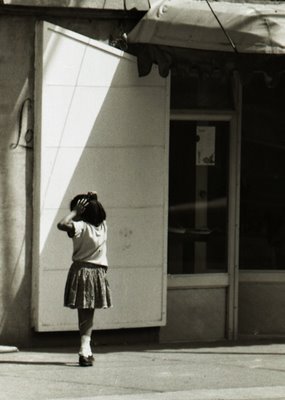 I have never been able to find the wonderful story (in a Penthouse Magazine) that I read some 25 or more years ago about Domenico Scarlatti being time machined into a modern times Los Angeles and how he abandoned his harpsichord and became a member of a rock band. My search into Google today to find that story only got me this which is my own blog from March 17 where I mentioned it Yesterday I was invited to a pre-Christmas gathering in the studio of Van Arts on West Hastings. I arrived a few hours late but early enough to watch projections of the digital images taken by many of my students. The photographs were sharp, had good composition, and some were most interesting. But in the end I became bored, and not necessarily, because the photographs were boring but perhaps simply due to the cynicism of an old man who has seen too many pictures and taken too many in his time. I heard another teacher near me say, "I just cannot get excited over photographs that don't elicit an emotional response in me." I am not going to label my excellent students as boring or state that they take pictures devoid of feeling. That would be unfair. I felt confused but I wanted to keep silent in their presence. They were cheerful and excited. I explained that I was a tad bored and within a few minutes one of my students, Patrick Young told me, "Alex you should lighten up." I countered with a, "Telling me to lighten up is like telling a nervous person to relax. It just doesn't work." But the smile on his face was almost catching. 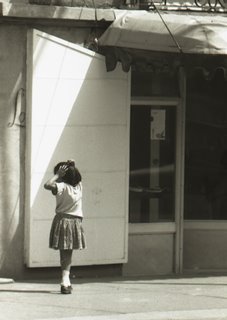 I had a chat with a much older photographer, Alan Jacques, whom I taught some years ago at Focal Point. He is a very good street photographer. He showed me some of his work which had appeared in a reputable photographic book. I looked at him in the eye and thinking of Domenico Scarlatti in Los Angeles going bonkers over a Moog synthethizer I asked him, "Do you think that if Henri Cartier-Bresson were brought back from the dead and brought to our present world that he be able to sell his photographs? Would anybody notice them?" I was afraid of Jacques's answer. I was right. He replied, "He would be ignored." As remarkable as Cartier-Bresson's photographs are and if you add to that the knowledge that to my generation (the pre-digital camera generation) his photographs are embedded in our memory, the fact is that when he was taking his photographs few had cameras and took pictures in the street. From my vantage point I divide photographers into two types. There are those who with camera in hand go out and look for pictures. They walk, they fly, they ride bicycles and when they see something that strikes their fancy (it could be funny, serious, whimsical, scary, ugly, beautiful, graphically arresting, etc) they take the picture. These photographers react to a situation that can either be an accident or one that they think will happen if they wait. In a border-line of this category would be the great landscape photographers like Ansel Adams who waited for the perfect light and discovered and or adapted methods of improving that light through negative processing control and master photo printing. In the other category are the photographers who don't wait for decisive moments. They create them and more often they create them in a studio where they can control the light and their subjects. I am a minor member of this second category. But all photographers dabble in both categories. Some do both well others choose one or the other and then specialize. The advent of the all-in-one digital single lens reflex has changed the playing field. You can take some pictures at 100 ISO and then, at will, shoot others at 3200. You can take all photographs in colour and convert any into b+w if you want. You can further get b+w infrared results(with relatively inexpensive programs like Paint Shop Pro, that mimic it to perfection. Pre-digital age the photographer wanting to do all that would have needed several cameras and lenses and facing the impossibility of reacting to a situation with more than one of them! The ability of the DSLR to react to any situation, with ample help from the human holding it, gives the photographer a sense of comfort and control even if it is a reaction, after the fact, of what has been noticed that has to be recorded or "captured" by the sensor. What that means is that we are getting tons of bad, good and even excellent Cartier-Bresson "decisive moment" pictures that are in bold and sharp colour. After seeing a few of these projected, ennui sets in. Vancouver's Fred Herzog has at long last received recognition (before his death, and yes he is still alive, and he went on record to point that out!) for his work in capturing a Vancouver long gone, with the Kodachrome. Those colours, the neon the places that Herzog photographed are gone and the same thing can be said, almost, about that Kodachrome. There is no way that modern digital cameras can take anything that remotely looks like Herzog's photographs. Perhaps Cartier-Bresson in our contemporary Vancouver would admire and become Herzog's friend. Perhaps both would go out and shoot in colour. 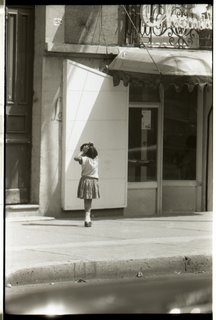 In 1963 I roamed the streets of Mexico City alone or with friends. We had cameras. They were early SLRs, Pentacon-Fs, Edixas, Pentax S-3 and Exaktas. The lenses we used were of questionable optics. Our light meters if dropped became innacurate. They had springs and moving parts. We took pictures of anything that we thought was interesting. Most of our pictures were boring or were badly taken and or cropped with no sense. The picture that leads this blog is version 3 of a negative I took in 1963. I have scanned it three ways here. It replicates what I originally did in the darkroom. Back in 1963 I had yet to discover the pleasure and discipline of cropping inside my viewfinder. I opted for cropping the negative with my enlarger. You see here how that image progressed. In this last, at the bottom, is the roof of the car on the other side of the street. I must have been behind it. I did not have zoom lens and was stuck with the lens on my camera. I am almost sure that had I run into someone like me now, then, I would have been told how my work was sloppy, unsharp, unimaginative and plain boring. My students now have far more challenges to face than I did then. Film technology was hit or miss and when pictures turned out we said just that, "They turned out!" as if it were a miracle. Now images are captured routinely and unless there is some digital malfunction they turn out every time. The pressure is on originality. It is this pursuit, originality, with competition from so many that makes 2008 and 2009 so much more difficult than 1963. My inability to give any sound advice to my students makes me sad and helpless. It makes me jealous of that Penthouse Scarlatti who did just fine with that Moog synthethizer in LA and never looked back at his crude harpsichord and the music of his past. Perhaps my students as they look at their future with a smile on their face know something I don't know. If they are right this is indeed a good thing.
Maggie Langrick At The Helm Of The Artistic Ship
Thursday, December 18, 2008
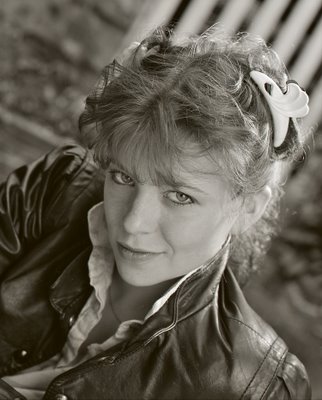
Recently the Vancouver Sun announced the hiring of Maggie Langrick as the new Arts Editor.
In July 1987 I photographed a 16-year-old Margaret Langrick (above) for a profile by John Lekich for the Georgia Straight. Lekich had already written about her two years before for the Globe & Mail when the actress had appeared in director Sandy Wilson's (below right) debut and BC smash hit film My American Cousin. I photographed Langrick in the garden of her mother's house somewhere in the Westside. For years I have been asking Lekich, "Whatever happed to Margaret Langrick. A couple of days ago I found out that the Vancouver Sun had hired a new Arts Editor called Maggie Langrick. I wondered. But this time around I didn't ask Lekich. I asked that infallible oracle of modernity, Google the question. The reply was instant:
From: WikiAnswers Q&A the wiki way
Q: What ever happened to Margaret Langrick?
In: Authors Poets and Playwrights
Answer
Margaret is now known as Maggie Sansom, and she writes for "Echo Memoirs".
I gather that Maggie Langrick, Margaret Langrick and Margaret Sansom are all the same person. I guess that Langrick has had extensive experience in public relations. This bodes well for the Vancouver Sun as they need all the positive public relations they can get these days with the declining opinion that people over 25 have of these hard copy web pages we used to call newspapers.
In the 35 years I have lived in Vancouver I can recall two arts editors who were effective even if one of them was not, strictly speaking, and arts editor. Whenever Max Wyman was at the helm as either and arts editor or a Saturday Magazine editor things were hopping. When Charles Campbell created Queue after having had a difference of opinion with the powers at the Straight his creation was instantly called "a real magazine" by my wife Rosemary who knows everything. The rest of the arts editors are a blur in my mind. To be fair perhaps they may not have obtained the backing or authority from above or "management" as Campbell called them. The Tyee's David Beers did the same as Campbell did for Queue for the interesting, challenging and appealing Sa turday Mix which disappeared as soon as Beers left via his boss's exit to the Chewing Gum Capital of the US.
Since Langrick took the helm as Arts Editor I have already noticed that a piece on Ballet BC's trouble with their roommate, the Scotia Bank, that was prominently covered by the Globe, was ignored by the Vancouver Sun.
If you only stop to think and notice that organizations like:
Ballet BC, the VSO, the Vancouver Opera, the Pacific Baroque Orchestra, the Vancouver Recital Society, the Playhouse, the Arts Club Theatre Company, the Vancouver East Cultural Institute, Gateway Theatre, Theatre Conspiracy, Arts Umbrella, Kidd Pivot, Lola Dance, Karen Jamieson, the Museum of Anthropology, the Vancouver Art Gallery, the Bill Reid Gallery, the Equinox Gallery, Diane Farris Gallery, Bau-Xi Gallery, the New Music Society, the Kay Meek Centre, the Turning Point Ensemble, the UBC School of Music, the Electric Theatre Company, Early Music Vancouver, Goh Ballet, EDAM, Brief Encounters/Solo Collective, Movent/Dances for the Small Stage, Bard on the Beach , Coastal Jazz & Blues Society, and many more galleries, theatre companies, musical organizations, dance companies and all sorts of yearly festivals like the Vancouver Festival or art crawls... and many more that I may have forgotten all advertise in the Vancouver Sun you would think of a situation similar to that of the rhinoceros and the oxpecker or askari wa kifaru . One needs the other. If one is healthy so will the other be healthy.
The same can be said of author and book reviews. Publishers and book festivals also buy ad space. Why is it that we cannot have at least one book review per day insted of a paltry few on a Saturday?
I cannot understand why it is that our Vancouver newspapers seem to:
1. Categorize the arts with food (turkeys for newbies), fitness and style/fashion.
2. Consider reviews important in a city where the lack of real review competition makes a review close to useless particularly when the review is that of a last performance. Its been years since I would read of the rivalry between Les Bewley and Alan Fotheringham. Now that was fun!
3. There is rarely that-in-depth preview explaining for example that if Ballet BC wants to mount a ballet by the famous American choreographer William Forsythe (something Ballet BC did many years ago when cutting edge Forsythe wasn't so famous but our very own John Alleyne knew what was good for us as he indeed did) a sum of upwards of $85,000 in royalty fees has to be paid plus an assistant choreographer has to be brought to Vancouver for supervision (air fare, hotel, etc!). A good pre-view prepares a performance for a viewer. It can inform, educate, inspire and even sometimes persuade a person to turn off the TV and purchase a ticket for a performance.
On a lark I went to a Turning Point Ensemble concert featuring Olivier Messiaen's Quartet for the End of Time. I had not liked Messiaen's choral works in the past and even though this was not one I was reluctant. The performance was one of the most satisfying of the year for me. Like Vancouver Opera's recent production of Eugene Onegin this sort of stuff does not happen often in Vancouver. I talked with Vancouver Sun's musical critic Lloyd Dykk today about the Messiaen and his one word comment was, "Sublime." Dykk did not go to the concert. Perhaps he did not know about it. Probably the reason is that one critic cannot go to everything. It is my feeling that in a "one newspaper town" the newspaper should have more than one music critic, several dance critics and theatre critics and at least one critic who specializes in painting and sculpture.
One solution to the lack of sufficient critics and reviewers is to hire freelancers. The newspaper does not have to spend on health plans, dental plans, etc. In a city where architecture plays such a large part of our life I believe that the only architecture writer is The Tyee's Adele Weder. If true, that is an outstandingly embarrassing fact.
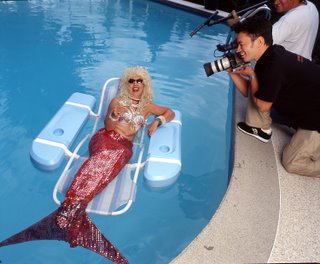
I wish Maggie Langrick all the best in what is going to be a tough job. It is my hope that she will help make our city newspaper into a viable one that promotes, explains, educates and reports on its rich artistic milieu. If the newspaper fails, both it and our art organizations will flounder and perhap sink. Sandy Wilson's floating deck chair will not help the sinking of the cultural ship.
What would be the first priority on a possible arts agenda? I would convene a meeting/party with all the publicists and marketing directors of the arts organizations of our city and suburbs (consider that excellent Surrey Art Gallery and North Vancouver's Presentation House) to discuss ways of promoting the arts. The Vancouver Sun could stipulate deadlines for press releases and requirements for handed in images and art. The Sun should consider that if several newspapers in town use the same images to promote the opera (as an example) this will diminish interest. Original art, while more expensive can be more effective. I would also invite all the public, city, provincial and private funding organizations that give money to the arts to also discuss possible strategy.
In the time of Brooks Joyner at the Vancouver Art Gallery and Jim Delgado at the Maritime Museum I remember that they had lunch every month (sometimes with the then director of the Museum of Anthropology) to discuss joint shows. It was not too long ago that the Presentation House had a show of the photographs of Robert Frank (The Americans) while the Pacific Cinemateque projected Franks avant-garde films. With the cross referencing boon of computers, arts organizations have to organize and work together.
We still don't have a detailed schedule or plan as to what local talent the Vancouver Olympic Committe is planning for 2010. I saw a fabulous Chinese fan dance at the Goh Ballet. I am thinking that the Vancouver Opera's Native Canadian slant on Mozart's The Magic Flute would be an obvious pick. Anosh Irani's Indian plays shown at the Arts Club, the Playhouse production of Kevin Loring's Blood Mixes Inside My Heart should be a must. Many of the brief but funny and interesting dance sketches of Brief Encounters or Dances for the Small Stage would be economical to perform and they would be popular to children, too. BC based plays like the Ruby Slippers production of Trout Stanley would show how good theatre is here. Another option would be the Electric Theatre Company's play Studies in Motion: The Hauntings of Eadweard Muybridge by our young playwright Kevin Kerr.
We have an active new music society and performers like Peggy Lee that get recognition in the NY Times but are all but invisible in Vancouver. We have the Pacific Baroque Orchestra and the Vancouver Symphony that comission work to local and Canadian contemporary composers.
Is VANOC considering these options? Is the Vancouver Sun investigating this?
|





















